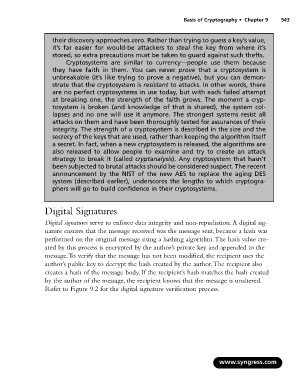Page 559 - StudyBook.pdf
P. 559
Basis of Cryptography • Chapter 9 543
their discovery approaches zero. Rather than trying to guess a key’s value,
it’s far easier for would-be attackers to steal the key from where it’s
stored, so extra precautions must be taken to guard against such thefts.
Cryptosystems are similar to currency—people use them because
they have faith in them. You can never prove that a cryptosystem is
unbreakable (it’s like trying to prove a negative), but you can demon-
strate that the cryptosystem is resistant to attacks. In other words, there
are no perfect cryptosystems in use today, but with each failed attempt
at breaking one, the strength of the faith grows. The moment a cryp-
tosystem is broken (and knowledge of that is shared), the system col-
lapses and no one will use it anymore. The strongest systems resist all
attacks on them and have been thoroughly tested for assurances of their
integrity. The strength of a cryptosystem is described in the size and the
secrecy of the keys that are used, rather than keeping the algorithm itself
a secret. In fact, when a new cryptosystem is released, the algorithms are
also released to allow people to examine and try to create an attack
strategy to break it (called cryptanalysis). Any cryptosystem that hasn’t
been subjected to brutal attacks should be considered suspect. The recent
announcement by the NIST of the new AES to replace the aging DES
system (described earlier), underscores the lengths to which cryptogra-
phers will go to build confidence in their cryptosystems.
Digital Signatures
Digital signatures serve to enforce data integrity and non-repudiation.A digital sig-
nature ensures that the message received was the message sent, because a hash was
performed on the original message using a hashing algorithm.The hash value cre-
ated by this process is encrypted by the author’s private key and appended to the
message.To verify that the message has not been modified, the recipient uses the
author’s public key to decrypt the hash created by the author.The recipient also
creates a hash of the message body. If the recipient’s hash matches the hash created
by the author of the message, the recipient knows that the message is unaltered.
Refer to Figure 9.2 for the digital signature verification process.
www.syngress.com

